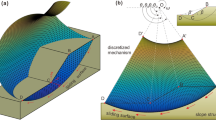Abstract
Horizontal resistance can be significantly different for gravel soil slope sites with different gradients. Slope angle effects on the horizontal resistance and the safety and stability of the structure are important in the design of pile foundations. In this paper, the effects of slope angle on the p–y curves are studied via in situ lateral load testing on eight piles installed in gravelly soil; the deflection of piles versus load curves and the resulting p–y curves for piles at different slope angles are compared. The outcomes are used to establish the initial stiffness (kini) and the ultimate subgrade reaction of soil (pu) as a function of the slope angle, which can be used to further develop standardized p–y curves for gravelly soil conditions in sloping ground. The analysis shows the proximity of the slope angle has small effects on kini of the p–y curves when soil displacement is under 3 mm; otherwise, the proximity of the slope angle adversely affected the p–y curves. Furthermore, kini is reduced close to the ground surface and gradually increases with depth until it finally becomes equal to the value of level ground. The ratio between pu in slope ground and level ground was determined as 0.79, 0.63, and 0.50 for slope angles of 15°, 30°, and 45°. The newly developed p–y curves were cross-validated using another in situ test. The findings of these analyses showed that the predicted responses of piles with the new p–y curves are in good agreement with the results of the in situ test. The difference between the actual and predicted p–y curves was approximately 20% for maximum bending moment and 5–10% for maximum displacement.


















Similar content being viewed by others
References
American Petroleum Institute (2002) Recommended practice for planning, designing and constructing fixed offshore platforms-working stress design. API Publishing Services, Washington, D.C.
Badoni D, Makris N (1996) Nonlinear response of single piles under lateral inertial and seismic loads. Soil Dyn Earthq Eng 15:29–43
Brown D, Shie CF (1991) Some numerical experiments with a three dimensional finite-element model of a laterally loaded pile. Comput Geotech 12:149–162
Chae KS, Ugai K, Wakai A (2004) Lateral resistance of short single piles and pile groups located near slopes. Int J Geomech 4(2):93–103
Chang SB, Zhang SM (2007) Handbook of engineering geology ( Fourth Edition ). China Architecture &Building Press, Beijing
Chen YM, Xu DP (2008) Case study of foundation engineering using FLAC/FLAC3D. China Waterpub Press, Beijing
Dawson EM, Roth WH, Drescher A (1999) Slope stability analysis by strength reduction. Geotechnique 49(6):835–840
Georgiadis K, Georgiadis M (2007) Behaviour of lateral loaded piles in sloping ground comparison between 3D Finite Element and P-Y analyses. In: London, UK: Proceedings of the 6th International Offshore Site Investigation and Geotechnics Conference: Confronting New Challenges and Sharing Knowledge:11-13
Georgiadis K, Georgiadis M (2010) Undrained lateral pile response in sloping ground. JGGE ASCE: 1489-1500.
Georgiadis K, Georgiadis M (2012) Development of P-Y curves for undrained response of piles near slopes. Comput Geotech 40(53–61):53–61
Georgiadis M, Anagnostopoulos C, Saflekou S (1992) Centrifugal testing of lateral loaded piles in the sand. Can Geotech J 29(2):208–216
Georgiadis K, Georgiadis M, Anagnostopoulos C (2013) Lateral bearing capacity of rigid piles near clay slopes. Soils Found 53(1):144–154
Li Y, Byrne PM (1992) Lateral pile response to monotonie pile head loading. Can Geotech J 29:92–106
Lymon C, Reese LC et al (2006) Analysis and design of shallow and deep foundation. JOHN WILEY & SONS.INC
Matlock H (1970) Correlations for design of lateral loaded piles in soft clay. In: The Proceedings of the Second Offshore Technology Conference. Houston, Texas, pp 577–594
Mezazigh S, Levacher D (1998) Lateral loaded piles in sand slope effect on P–Y reaction curves. Can Geotech J 35:433–441
MOHURD (2001) Code for investigation of geotechnical engineering (GB50021-2001). China Architecture &Building Press, Beijing
MOHURD (2008) Technical code for building pile foundations (JGJ 94-2008). China Architecture &Building Press, Beijing
NCHRP (2001) Static and dynamic lateral loading of pile groups. National Research Council
Nimityongskul N (2010) Effects of soil slope on lateral capacity of piles in cohesive soils. Oregon State University
Rajashree SS, Sitharam TG (2001) Nonlinear finite element modeling of batter piles under lateral load. J Geotech Geoenviron 127:604–612
Reese LC (1974) Analysis of lateral loaded piles in sand. In: The Proceeding of the fifth Offshore Technology Conference. Dallas, Texas, pp 473–485
Reese LC, Welch RC (1975) Lateral loading of deep foundations in stiff clay. J Geotech Eng Division, ASCE 101(7):633–649
Reese LC, Cox W, Koop F (1975) Field testing and analysis of lateral loaded piles in stiff clay. In: Proceeding of the Seventh Offshore Technology Conference. Houston, Texas, pp 671–690
Reese LC, Wang ST, Isenhower WM, et al. (2004) Computer Program LPILE Plus Version 5.0 Technical Manual. Ensoft, Inc., Austin, Texas
Resee LCRF (2011) Single piles and pile groups under lateral loading, 2nd edn. CRC Press
Sivapriya SV, Gandhi SR (2013) Experimental and numerical study on pile behaviour under lateral load in clayey slope. Indian Geotech J 43(1):105–114
Wang S, Reese LC (1993) COM624P-Lateral loaded pile analysis program for the microcomputer, version 2.0. FHWA-SA-91-048, U.S. DOT, Federal Highway Administration.
Zhao QH, Peng SQ, Chen JB (2015) The report of the proportional coefficient of lateral resistance (m-Value) of pile foundations on sloping ground. Chengdu University of Technology, Chengdu. China
Acknowledgments
We are particularly thankful to Mr. Michael for suggestion and helpful reviews.
Funding
Financial support for this investigation was provided by national Basic Research Program of China (2011CB13501), and Chang-jiang scholars and Innovative team development plan (IRT0812).
Author information
Authors and Affiliations
Corresponding author
Additional information
Responsible Editor: Zeynal Abiddin Erguler
Rights and permissions
About this article
Cite this article
Zhao, Qh., Chen, Jb. & Peng, Sq. Terrain slope angle effect on p–y curves for piles in gravelly soil. Arab J Geosci 13, 537 (2020). https://doi.org/10.1007/s12517-020-05349-z
Received:
Accepted:
Published:
DOI: https://doi.org/10.1007/s12517-020-05349-z




